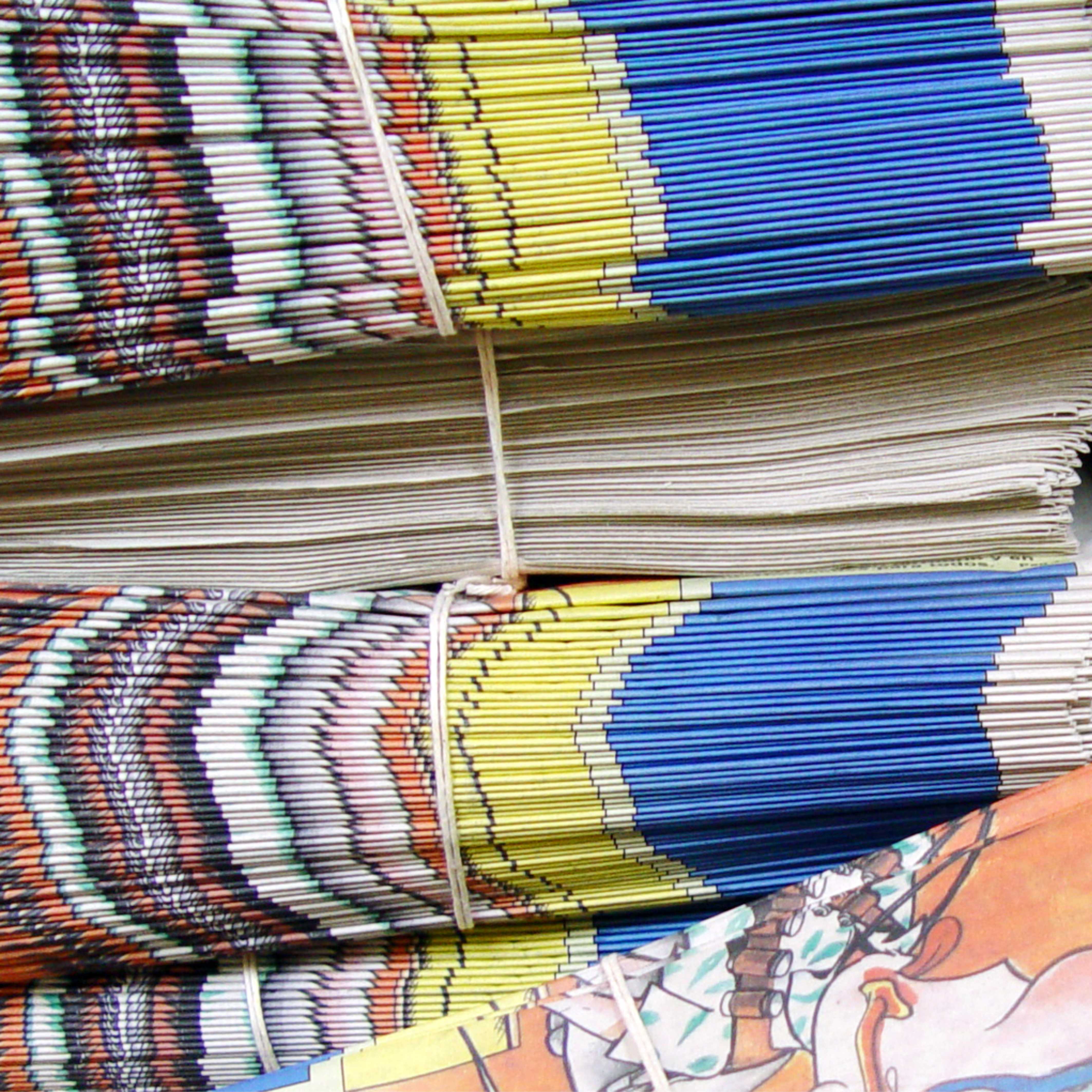A Compostable Screening Material Currently Approved and Available Commercially.
 NatureNetting at London Olympics 2012UK based Ceres Media International PLC; a specialist materials company producing natural biodegradable materials for the print industry has released details of a new environmentally friendly material, NatureNetting™.
NatureNetting at London Olympics 2012UK based Ceres Media International PLC; a specialist materials company producing natural biodegradable materials for the print industry has released details of a new environmentally friendly material, NatureNetting™.
It is a compostable plant based natural netting with high tensile strength and excellent covering characteristics.
NatureNetting™ was developed in response to the demand from clients for an environmentally friendly material that would provide a robust screen yet still allow some visibility for security purposes. It took the technical team at Ceres five months to move from concept to a finished product and the company has commented that clients are now ordering. CERES MEDIA say the product has high density mesh and allows water and air to pass through it freely, is stable under all weather conditions and does not distort when wet. The product can be dyed to most pantone colours using Azo free dyes and can be made fire retardant (compliant to BS5867, BS5438 and BS7837) without affecting in any way the composting characteristics which makes it stand out when compared to other materials that are currently used for this purpose.
Multi-million euro business costs the exchequer over 100m a year in lost tax revenue.
It is estimated that in certain parts of the country up to a third of the diesel bought at fuel pumps could be ‘laundered’ by criminal gangs. This is the process carried out on subsidised diesel distributed to farmers which contains a dye to prevent it being sold at the pumps. The gangs remove this dye in ‘laundering factories’ using a chemical process and supply the washed fuel to petrol stations who sell it on to their customers for the full price. It is estimated that this multi-million euro business costs the exchequer over 100m a year in lost tax revenue.
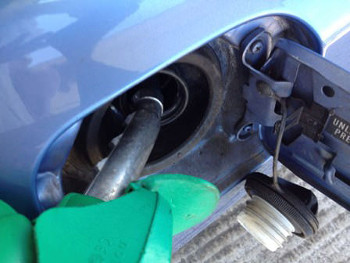 Petrol-tankBut there is another cost not as publicised as the lost revenue and that is the cost to the environment. Besides the fact that the laundered diesel can damage engines, the process itself requires the use of dangerous chemicals such as sulphuric acid and bleaching agents and results in a waste by-product, a tar-like chemical compound or sludge. This toxic substance, which is of no value to the gangs, is being abandoned in remote areas of the border counties under cover of darkness and is endangering the local environment.
Petrol-tankBut there is another cost not as publicised as the lost revenue and that is the cost to the environment. Besides the fact that the laundered diesel can damage engines, the process itself requires the use of dangerous chemicals such as sulphuric acid and bleaching agents and results in a waste by-product, a tar-like chemical compound or sludge. This toxic substance, which is of no value to the gangs, is being abandoned in remote areas of the border counties under cover of darkness and is endangering the local environment.
The waste sludge has been dumped near rivers and lakes and can seep into the watercourse, polluting drinking water and ground water. For the many people with private wells, it can be extremely dangerous and cause illness. It’s presence in rivers and lakes are also a threat, particularly to the valuable fishing industry in the border area. Last autumn, a river in Donaghmoyne in Monaghan, which is a spawning ground for winter salmon, was polluted when a load of the sludge was tipped into it.
Most of the petrol laundering is being carried out in the border areas specifically South Armagh and it is the border counties in the republic who are suffering the most from the dumping. Farmers are finding large plastic containers of this messy substance on their land and in isolated lanes and roads. The clean-up process costs the councils of Louth, Monaghan a lot of money and time. Since, 2005, Monaghan Co Council has spent €1.5 million to deal with 156 incidents of illegal dumping. There are no facilities in this country to treat the hazardous waste so it has to be shipped abroad for treatment.
Since the downturn, this illegal industry has increased with more and more legitimate petrol stations re-selling the washed diesel. Unfortunately, once the station owners accept this diesel, they become complicit and must continue taking the defective fuel.
This problem is increasing and it must be quite obvious to the government that the present system of subsidising farmers’ use of diesel is encouraging criminality. A change in the system similar to that used in Europe where the farmers buy the diesel for full price and receive a monetary rebate would wipe out the illegal industry but as yet there seems to be no political will to do so. So for the moment, the fragile ecosystem of Cavan, Monaghan and Louth remains in danger.
Rose Comiskey
What is the result of this cementing over of once green earth?
When my family came to Dublin forty-five years ago, the back garden of the house they moved into was a bare place. The estate was relatively new and the garden, like the others surrounding it, was enclosed by three ugly cement-block walls, with a few small saplings and a failed attempt at vegetable growing in one corner. Now, almost half-a-century later, all the gardens are lush with trees and shrubs and overgrown bushes. A green corridor at the back of the houses is home to a thriving animal and bird life. The unpromising saplings grew into tall trees and now birds nest in the branches. Squirrels live its hollows and foxes slink along the back walls after dark and make homes in the quieter gardens. The gardens have become a haven for wildlife.
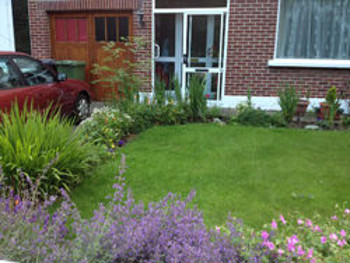 Old style garden The front gardens of these houses, however, are a different matter. The original residents have aged with their properties and are departing for their just rewards. The new, young owners renovate and expand and this expansion includes the paving over of the front garden to make way for the second car. The lawns are dug up and replaced with cement and gravel or neat paving or worst of all, a wall-to-wall, tar-black layer that resembles bubble-wrap. Even gardens in cul-de-sacs get the makeover treatment.
Old style garden The front gardens of these houses, however, are a different matter. The original residents have aged with their properties and are departing for their just rewards. The new, young owners renovate and expand and this expansion includes the paving over of the front garden to make way for the second car. The lawns are dug up and replaced with cement and gravel or neat paving or worst of all, a wall-to-wall, tar-black layer that resembles bubble-wrap. Even gardens in cul-de-sacs get the makeover treatment.
And what is the result of this cementing over of once green earth. Well, there are a number of outcomes. First is the effect on birds. The loss of greenery results in a loss of habitat. The disappearing grass means the end of the insects and grubs that live in and off it and consequently the end of a food source for the birds.
Every year, we lose more and more green space in out cities and town and consequently, a loss of natural drainage. This loss is one of the causes of the increased incidents of flooding we have experienced in that last number of years. The paved area cannot soak up the rainfall anywhere near as fast as the grassy areas resulting in run-off into drains which are unable to cope with the extra water in times of storms. Modern development has not helped through the practice of dispensing entirely with a grassed area in front of the new builds.
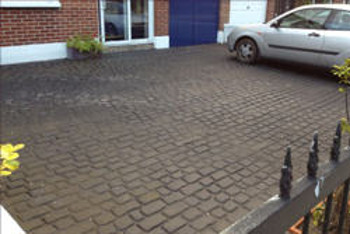 Paved garden Finally, there are aesthetic reasons for not paving over our grass. Gardens make for pleasant spaces in our increasingly cement-built urban areas. They can be an oasis of peace and a feast for the eye of the passer-by.
Paved garden Finally, there are aesthetic reasons for not paving over our grass. Gardens make for pleasant spaces in our increasingly cement-built urban areas. They can be an oasis of peace and a feast for the eye of the passer-by.
It’s in all our interests to think twice about getting rid of the green space at the front of the house and for the local authorities to increase and enforce the planning regulations governing garden development.
I would love to hear your views and opinions on this subject because it affects us all. Please leave a comment.
Rose Comiskey
Great to look at but do they pose environmental difficulties
The typical Irish urban garden is composed of peat, paving and imported exotic plants. However, all three pose environmental difficulties. The peat is derived from a finite source, our ‘precious bogs’ which are under threat, paving can cause water run-off problems and flooding and exotic plants can spell disaster in the wild and drive out our native species as happened with the azaleas and rhododendrons imported into Irish gardens over one hundred years ago. These plants can also disrupt the pollination process.
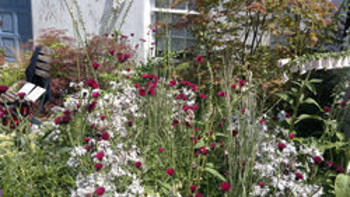 Green-Room-garden---Bloom-2012Environmentalists tell us we have to find alternatives but our love affair with all three shows no sign of abating.
Green-Room-garden---Bloom-2012Environmentalists tell us we have to find alternatives but our love affair with all three shows no sign of abating.
At this year’s Bloom, a number of show gardens offered a more ecological focus for our gardens using nature-friendly plants and materials. Bloom, the annual festival of gardening held in the Phoenix Park in Dublin, is a showcase for professional Irish gardeners and a hot house for new ideas.
Gold medal winners Patricia Tyrell and Deirdre Prince created the Green House a delightful space filled with native Irish plants and a flower-laden bicycle parked at the gate.
‘A lot of front gardens tend to be paved over these days,’ Deirdre told me. ‘They’re not very inviting and they contribute to a lot of water run-off and don’t create any areas for wildlife.’
The two women, both landscape gardeners, were inspired to create an urban garden that would address these problems. They used native plants and permeable pavement to slow down run-off and instead allow it to slowly release into the groundwater. Rainwater was harvested in a barrel, and the roof of a bin storage unit doubled as a herb garden showing you can have planting anywhere. ‘We hope we have created a space that’s inviting and also environmentally friendly,’ Deirdre added.
The house façade and the walls surrounding the garden were built using salvaged and recycled building materials. And the bike at the front was there to remind people that there are alternatives to the car.
Fiann O’Nuallain is a Bloom veteran and an ardent promoter of native Irish plants and trees. Last year, his garden caught the eye of the incumbent President Higgins and out of their conversation about how art and gardening merge grew his 2012 exhibit Stream of Consciousness.
‘The day after Bloom 2011 closed,’ Fiann told me, ‘this year’s garden was in train. All the plants were ‘wild-crafted,’ that is grown from seeds in the wild. The Hazel trees come from Kerry. Other plants and trees were grown on farms in Antrim.’
His garden, a ‘bronze age meadow, reproduces examples of Irish landscape – wetlands; woodlands; peatlands. You won’t find any peat compost in it or imported flowers. He uses nectar-rich native plants to attract bees and host plants for butterflies to lay their eggs on. Fiann hopes that both amateur and professional gardeners will follow his example
A number of other gardens at the show also took an environmental theme. The Cinema garden planted by fourteen students from Dundrum CFE drew on the silent film era and had as its centrepiece a recycled ‘casting’ couch planted with grass. Departures, a garden with the concept of emigration, used only recycled materials such as the wrought iron salvaged from the old Jervis Street Hospital. The REHAB Changing Perspectives garden contained only native Irish plants.
All of these gardens show that even the smallest of green spaces can contribute positively and sustainably to the environment as well as being aesthetically pleasing.
Rose Comiskey
Each spring, the pear farmers of Sichuan province in China get out their ladders and feather dusters to pollinate the trees in their orchards. It’s a painstaking, time-consuming job that should be done by bees but there are no bees in this province. Over-use of pesticides wiped them out years ago.
The problem of the missing bees is not confined to China. Worldwide there is a crisis in bee-keeping, with the bee populations decimated by a puzzling disease known as colony collapse disorder.
We tend to take the honey bee for granted, their pleasing drone a backdrop to summertime. But bees are essential to agriculture and are responsible for the pollination of up to 75 percent of world food crops. So the catastrophic drop in their numbers is a serious worry. In America, bee colonies are decreasing by over a third every year. The cause for the collapse is manifold and not easy to reverse but what is clear is that the problem is man-made.
The story of the decline of the honeybee has its roots in the revolution that occurred in agriculture in the twentieth century. Mixed farming gave way to largescale single-crop units. The wild honeybee numbers declined and a large and lucrative bee-keeping industry developed to fill the gap.
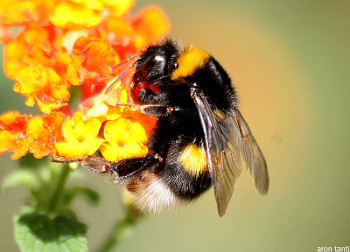 Every year, millions of bee-laden hives are transported across America to service the giant farms on both sides of the continent. This also occurs in Europe and other parts of the world. The bee has become a migrant worker for rent to farmers and, in the view of many, is over-worked, which has interfered with their natural cycle.
Every year, millions of bee-laden hives are transported across America to service the giant farms on both sides of the continent. This also occurs in Europe and other parts of the world. The bee has become a migrant worker for rent to farmers and, in the view of many, is over-worked, which has interfered with their natural cycle.
The type of bee used is also a factor. In the past, a diverse number of bee species inhabited the hives. Now the bee-keepers tend to stick to one or two varieties which lower the resistance to disease.
The new farming practices and the increased ease of transport meant that bees could be moved between continents but this also led to the exposure to new diseases. The varroa mite, a tick-like parasite is rampant in Asian bees but they have developed a resistance to it. When Western bees were exposed to the mite, however, they died in their millions.
But probably the greatest hazards for bees are pesticides. Certainly the bee crisis in China has been caused by their over-use. Pesticides are all-pervasive in the working bee’s environment The average bee can have up to ten pesticides present in its system and the flowers it feed on can have even more. A new type of super pesticide containing neoncotinoids has been identified as being particularly harmful. Tests have shown that this substance affects the bees’ ability to navigate – to perform the ‘dance of the honeybee’ that allows them to find their way back to the hive over great distances. These pesticides are, unfortunately, the most popular and best-selling in the world and have an influential commercial lobby backing their use. Many countries have now banned or limited their use.
The falling bee numbers may be linked to a combination of all these factors. But whatever the explanation, the task of finding a solution is urgent because many experts believe that the collapse could be more devastating than global warming because of the important role the bee plays in agriculture.
So next time you spread honey on your toast, think of the over-worked bee that produced it and remember those Chinese farmers clambering up ladders to play cupid to their fruit trees.
Rose Comiskey
Bio:
Rose Comiskey is a freelance editor, writer and photographer. She will be contributing occasional pieces on the environment to Digital Print News
{jcomments on}
CRON offers a two year guarantee that makes cost of ownership affordable
- CRON announces new additions to HDI Flexo CTP range: HDI 600H+, HDI 920H+ and HDI 1600H+
- New models deliver doubled laser power and speed for imaging resolutions up to 9600 dpi
HDI Flexo plate imaging will be at Labelexpo Europe
 CRON HDI Flexo 600
CRON HDI Flexo 600
CRON’s commitment to delivering exceptional quality prepress solutions and excellent value for money will be demonstrated during Labelexpo this September, with a showcase of the CRON HDI Flexo 600 and 1600 CTP models at the CRON stand (9B18).
Automation Arena will debut at this year’s Labelexpo Europe exhibition
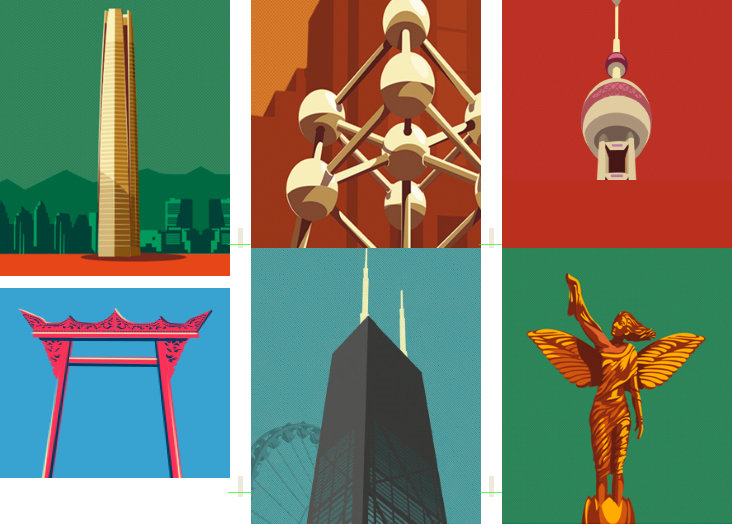 LabelExpo Europe
LabelExpo Europe
The organizers of Labelexpo Europe have announced full details of a ground-breaking new feature for 2017. The Automation Arena will debut at this year’s exhibition as Labelexpo Europe returns to Brussels Expo 25 - 28 September.
Océ customer programme for the technology
 Océ-VPi300 00008
Océ-VPi300 00008
The Océ VarioPrint i300 sheetfed inkjet press – officially launched by Canon Europe in 2016 – is delivering new levels of productivity, flexibility and quality for commercial and corporate customers worldwide, enabling them to meet a wide range of customer needs quickly, efficiently and cost-effectively.

